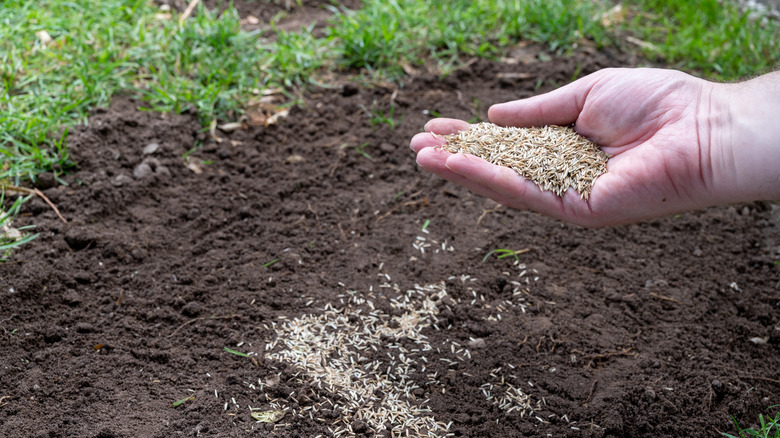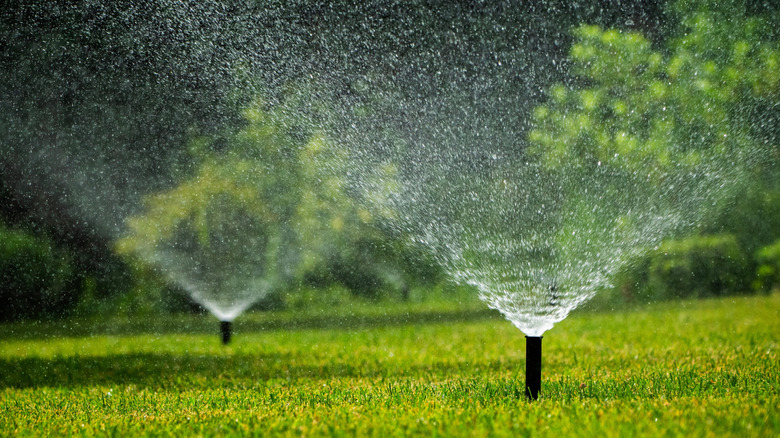The Drought-Tolerant Grass Seed That Will Have Your Lawn So Lush And Soft
Everyone wants a lush, green lawn — the kind that encourages you to kick off your shoes and go barefoot — but that's not always an easy feat. Many grass varieties can be picky about water, soil, and climate, and it's frustrating when you do everything "right" and still end up with a sparse, brown lawn. If you want a gorgeous lawn without all the fuss, consider seeding your yard with zoysia.
Commonly known as Korean or Japanese lawn grass, zoysia is a warm-season turf grass that can withstand drought, heat, and cold. Because it's so versatile, zoysia is a perfect grass for the transition zone, an area of land between growing regions that experiences both cold winters and sweltering summers. It thrives in full sun and is also well-suited to southern regions. Zoysia's blades grow densely and can withstand heavy foot traffic and play.
Growing this grass from seed is simple, but it's a slower process than some grass varieties, which is why many people use sodding, plugging, or sprigging to start the grass. Zoysia typically germinates in two to three weeks, and once it's established, it requires minimal maintenance.
How to grow zoysia from seed
Before seeding, you should test your soil's pH levels to make sure the growing conditions are ideal. Zoysia prefers slightly acidic soil. A good pH for this grass variety is between 6 and 6.5, so amend the soil as needed to achieve this range. If your soil is more alkaline, your zoysia might appear yellow-green. It's best to plant zoysia seeds in late spring to early summer. However, it is possible to sow them in early fall, at least two months before the first frost. For an even spread of seed, rake through your yard to break up dense chunks of soil and remove debris. Raking the soil also creates a soft, loose top for seeds to rest.
A seed spreader will help you lay an even layer of seed, but it's not necessary to use one. If you seed by hand, be conservative in your approach and adjust the seed as needed to avoid overseeding. Zoysia seeds germinate in direct sunlight, so you shouldn't cover them with soil. Keep the soil consistently moist while the seeds germinate. Zoysia will turn brown as it goes dormant for the winter. For a green lawn year-round, you can plant zoysia with tall fescue. When zoysia dies back, tall fescue thrives in fall and spring.
How to maintain zoysia
While zoysia is drought-tolerant, a regular watering schedule will yield the best lawn. When your grass is first establishing, plan to water it daily for the first two weeks. Once it's established, you can reduce the frequency to once or twice a week at about an inch of water per session. Occasional deep watering will support a strong root system. Zoysia will typically thrive without any fertilizer, but for optimal results, you can follow a simple fertilization schedule. Plan to apply a slow-release nitrogen fertilizer in the spring, a high-potassium fertilizer in the summer, and a low-nitrogen fertilizer in the fall. The grass shouldn't be fertilized in the winter while it's dormant.
Zoysia is a slow-growing grass, so it doesn't require frequent mowing. When you do mow it, make sure your mower's blades are sharp. Zoysia's course blades can dull mowers quickly. The ideal height for zoysia is about 1 to 2 inches. Avoid mowing your lawn too often. Cutting more than 1/3 of the grass's length at a time forces it to focus its energy on regrowing rather than maintaining healthy structures. Dethatching your zoysia is optional, but it can help the overall health of your lawn.


